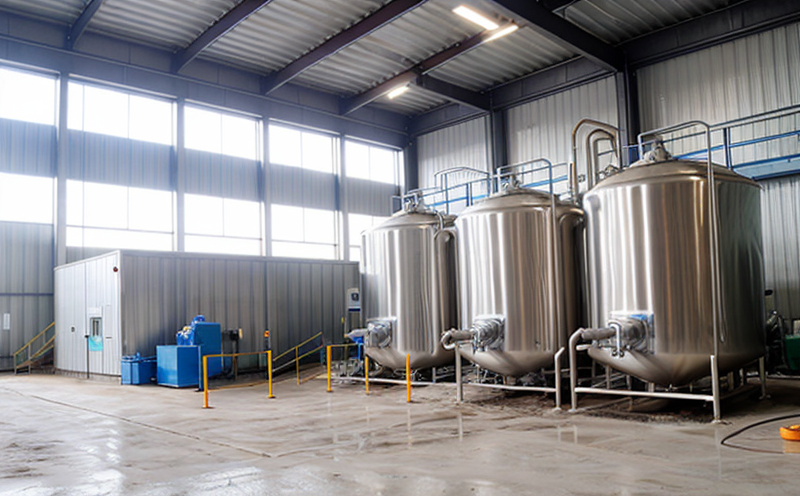EPA 525 Herbicides Test in Process Water
The EPA 525 herbicides test is a crucial procedure conducted to ensure compliance with environmental regulations and protect public health. This test evaluates the presence of herbicides in industrial process water, which can be contaminated from various sources such as agricultural runoff or accidental spills during manufacturing processes.
Herbicide contamination in industrial process waters poses significant risks to both human health and aquatic ecosystems. Regulatory bodies like the Environmental Protection Agency (EPA) have established specific guidelines and standards to mitigate these risks effectively. The EPA 525 herbicides test is designed to detect and quantify specific herbicides, ensuring that water meets the prescribed safety thresholds.
The scope of this testing extends beyond mere detection; it aims to provide actionable insights into the potential sources of contamination within industrial facilities. By identifying which herbicide compounds are present at various stages of production, companies can implement targeted mitigation strategies and enhance overall environmental stewardship.
For quality managers and compliance officers responsible for ensuring regulatory adherence, this test is essential. It helps in tracking the effectiveness of pollution control measures and provides a basis for decision-making regarding necessary corrective actions. For R&D engineers and procurement personnel, understanding these tests can inform material selection processes and process optimization efforts aimed at reducing contamination risks.
The methodology employed in EPA 525 herbicides testing involves several key steps, including sample collection, extraction, cleanup, and analysis using advanced analytical techniques such as liquid chromatography coupled with mass spectrometry (LC-MS/MS). These sophisticated methods allow for highly sensitive detection of even trace amounts of herbicides.
The results obtained from this testing play a pivotal role in guiding corrective actions. They can influence decisions about process improvements, raw material sourcing, and waste management practices. By leveraging accurate data from EPA 525 tests, organizations not only comply with legal requirements but also contribute positively to environmental conservation efforts.
In conclusion, the EPA 525 herbicides test is more than just a regulatory compliance exercise; it represents an integral part of sustainable industrial operations aimed at minimizing ecological footprint and promoting responsible resource use. Through rigorous testing protocols and continuous monitoring practices, industries can ensure that their water treatment systems effectively protect both people and nature.
Applied Standards
The EPA 525 herbicides test adheres to stringent international standards such as ISO/IEC 17025, which sets criteria for the competence of testing laboratories. Compliance with these standards ensures that results are accurate and reliable.
Specifically tailored towards detecting herbicides in process water, EPA Method 525 utilizes a combination of sample preparation techniques, including solid-phase extraction (SPE) or liquid-liquid extraction (LLE), followed by gas chromatography-mass spectrometry (GC-MS) or high-performance liquid chromatography (HPLC). This approach guarantees precise quantification and identification of herbicide residues.
It is important to note that while the EPA 525 method focuses primarily on herbicides, it may also incorporate other analytical procedures depending on the specific contaminants present in the sample matrix. For instance, if pesticides are suspected alongside herbicides, additional methods like EPA Method 621 might be employed.
By adhering to these rigorous standards and utilizing state-of-the-art instrumentation, laboratories can deliver reliable data that supports informed decision-making processes within industrial settings.
Scope and Methodology
| Step | Description |
|---|---|
| Sample Collection | Water samples are collected from various points along the industrial process pipeline. These locations should represent different stages of water treatment and usage to ensure comprehensive coverage. |
| Extraction | Solid-phase extraction (SPE) cartridges or liquid-liquid extraction (LLE) methods are used to concentrate herbicides from the aqueous phase into smaller volumes for subsequent analysis. This step enhances sensitivity and reduces matrix effects. |
| Cleanup | The extracted samples undergo additional purification steps to remove interfering substances, ensuring clean extracts suitable for accurate quantification via LC-MS/MS or HPLC. |
| Analysis | Analytical instruments like GC-MS or HPLC equipped with tandem mass spectrometry capabilities are used to identify and quantify herbicides present in the sample. The instrument settings must be optimized for maximum specificity and sensitivity. |
Quality and Reliability Assurance
To ensure the highest levels of accuracy and reliability, our laboratory employs robust quality management systems compliant with ISO/IEC 17025. Regular internal audits and proficiency testing programs are conducted to maintain consistency in analytical performance.
Certified analysts perform all EPA 525 herbicides tests using standardized procedures that have been validated internally as well as externally against reference laboratories. This dual validation process ensures that results are traceable back to internationally recognized standards.
Instrument calibration and method verification are carried out regularly according to established schedules, ensuring that analytical instruments operate at optimal levels throughout the testing period. Additionally, quality control samples are analyzed concurrently with customer samples to monitor instrumental drift or operator error.
Our commitment to excellence extends beyond technical proficiency; we also prioritize client satisfaction by providing timely communication regarding test progress and results. Upon completion of an EPA 525 herbicides test, detailed reports highlighting findings along with recommendations for further action are delivered promptly.





